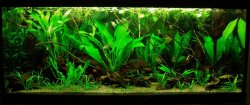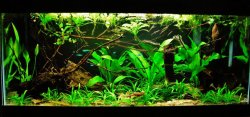Hey everyone. I have been lurking for some time while setting up my son's first fish tank.
So my 5 year old son has been wanting to set up a fish tank for a long time. I finally caved and we got a Marineland 10-gallon set up with the Biowheel filter and a 100W heater.
I tried to "go it alone" and, as a science-oriented guy, figured it'd be OK. But, alas, I have had some questions over the months...
Let's start with water chemistry as I have read that's how folks like it here!
Tap water pH 7.6
Tap water TDS 38ppm (General Hardness well below 170ppm considered for "hard water")
Fish tank water as measured today:
Ammonia 0ppm
Nitrite 0ppm
Nitrate 10ppm
pH 6.4 (<----- I'm sure this is a LOT of the problem)
TDS 400ppm (<--- wowsers! Pretty hard...)
Temperature 78.5* F
Current stock:
4 Neon Tetra standard size, ~1"
1 Albino Cory Cat, ~1.5"
Until earlier today... also a BN Pleco, ~1.5"
Numbers-wise, seems understocked a little, shooting for the 1" of fish per 1G of water rule, so that certainly shouldn't be an issue as the Ammonia count shows, it isn't, right?
The nitrogen cycle seems good and in working order.
The BN Pleco died today after being miserable for a couple of days and causing me to worry if I should euthanize him. Oye.
Now, I did add a piece of driftwood in the tank for the BN Pleco which we added approx. 3 weeks ago. I have read that this can leech tannins and other things into the water and can acidification. True?
I have read a lot about water hardness hence why I used some work tools and measured the TDS. Our tap TDS is pretty great. But once it's in the tank the TDS skyrockets to over 400ppm. When folks discuss GH on the forum, are they discussing it with regards to the tap water TDS as it begins, or once in the tank? If the latter, how is there such a discrepancy between our chemically excellent water and the water once it's in the tank? Can anything be done about that or is it normal?
I am tempted to remove the driftwood, place it in a smaller 2 gallon tank, and see if pH changes over time. But that's a long term test and won't help my fish environment in the short term I don't think. Or would it?
Whew. Well I'm aiming to keep the remaining 4 Tetras and 1 Cory Cat alive, for my son's sake and mine, while we figure this out.
I do weekly 10% water changes also with gravel siphoning.
I know that's a big wall of text up there but I truly appreciate any and all insight into what's going on and if I need to change the kind of fish I've got in the tank. I know Tetras and Corys are "soft water fish" and our tap is most certainly soft at ~30-40ppm, but in the tank, it's 400+, so do I need Livebearers and that kind of thing? If so, am I kind of stuck with 10G, being so small for larger fish?
Looking forward to ANYTHING you fine folks want to chip in and let's bat it around a bit.
Thank you!!!
Anthony
So my 5 year old son has been wanting to set up a fish tank for a long time. I finally caved and we got a Marineland 10-gallon set up with the Biowheel filter and a 100W heater.
I tried to "go it alone" and, as a science-oriented guy, figured it'd be OK. But, alas, I have had some questions over the months...
Let's start with water chemistry as I have read that's how folks like it here!
Tap water pH 7.6
Tap water TDS 38ppm (General Hardness well below 170ppm considered for "hard water")
Fish tank water as measured today:
Ammonia 0ppm
Nitrite 0ppm
Nitrate 10ppm
pH 6.4 (<----- I'm sure this is a LOT of the problem)
TDS 400ppm (<--- wowsers! Pretty hard...)
Temperature 78.5* F
Current stock:
4 Neon Tetra standard size, ~1"
1 Albino Cory Cat, ~1.5"
Until earlier today... also a BN Pleco, ~1.5"
Numbers-wise, seems understocked a little, shooting for the 1" of fish per 1G of water rule, so that certainly shouldn't be an issue as the Ammonia count shows, it isn't, right?
The nitrogen cycle seems good and in working order.
The BN Pleco died today after being miserable for a couple of days and causing me to worry if I should euthanize him. Oye.
Now, I did add a piece of driftwood in the tank for the BN Pleco which we added approx. 3 weeks ago. I have read that this can leech tannins and other things into the water and can acidification. True?
I have read a lot about water hardness hence why I used some work tools and measured the TDS. Our tap TDS is pretty great. But once it's in the tank the TDS skyrockets to over 400ppm. When folks discuss GH on the forum, are they discussing it with regards to the tap water TDS as it begins, or once in the tank? If the latter, how is there such a discrepancy between our chemically excellent water and the water once it's in the tank? Can anything be done about that or is it normal?
I am tempted to remove the driftwood, place it in a smaller 2 gallon tank, and see if pH changes over time. But that's a long term test and won't help my fish environment in the short term I don't think. Or would it?
Whew. Well I'm aiming to keep the remaining 4 Tetras and 1 Cory Cat alive, for my son's sake and mine, while we figure this out.
I do weekly 10% water changes also with gravel siphoning.
I know that's a big wall of text up there but I truly appreciate any and all insight into what's going on and if I need to change the kind of fish I've got in the tank. I know Tetras and Corys are "soft water fish" and our tap is most certainly soft at ~30-40ppm, but in the tank, it's 400+, so do I need Livebearers and that kind of thing? If so, am I kind of stuck with 10G, being so small for larger fish?
Looking forward to ANYTHING you fine folks want to chip in and let's bat it around a bit.
Thank you!!!
Anthony



 /www.amazon.com/20-Standard-Reference-Calibration-Instruments/dp/B00B6QI57M/ref=sr_1_4?s=industrial&ie=UTF8&qid=1471651220&sr=1-4&keywords=TDS+reference+solution
/www.amazon.com/20-Standard-Reference-Calibration-Instruments/dp/B00B6QI57M/ref=sr_1_4?s=industrial&ie=UTF8&qid=1471651220&sr=1-4&keywords=TDS+reference+solution

